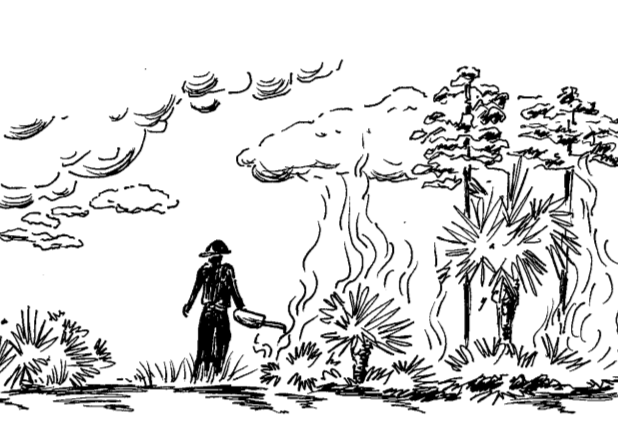Last updated: August 8, 2025
Lesson Plan
Fire Metaphors

The first of four lessons about the importance of fire to an ecosystem! Big Cypress is a fire adapted ecosystem, and students will dive deeper into what that truly means!
NPS Graphic
- Grade Level:
- Upper Elementary: Third Grade through Fifth Grade
- Subject:
- Science
- Lesson Duration:
- 60 Minutes
- State Standards:
- SC.4.L.17.4
LAFS.4.L.3.5
Essential Question
What connections can students draw between household or everyday objects and the importance of fire to an ecosystem?
Objective
In this activity, students will:
1. Describe the characteristics of fire and evaluate the importance of fire to the plants, animals, and habitat of the Big Cypress National Preserve.
2. Use metaphors to better understand how fire interacts with an ecosystem and improve student’s own perception of fire.
Background
Fire is a natural part of the South Florida ecosystem and plays a crucial role in how plants and animals survive. People can have a variety of responses to fire; while some are fearful, others are aware of the beneficial nature fires have on the ecosystem.
Fires can start from a variety of different causes and their outcomes can change based on current weather and fuel conditions. The types of wildland fires that primarily occur within Big Cypress National Preserve are either caused by lightning strikes, humans, or prescribed fires ignited by park rangers.
In order for a fire to begin, there must be three things present: oxygen, heat, and fuel. If one or more of these three components is missing the fire will not ignite; if one or more of these three components is removed (such as covering the fire with a blanket to remove the oxygen) the fire will go out. The oxygen side of the triangle is provided by the atmosphere. Fuel is defined as any sort ofmaterial that can undergo a chemical or physical reaction to generate heat energy. Fuel for fires is commonly grass, shrubs, trees, and other vegetation types. The two most common forms of heat to start a fire are lightning and some type of anthropogenic (human caused) action such as a cigarette, unattended campfire, prescribed fire, etc.
What are the benefits of fire? One of the vital roles a fire plays in an ecosystem is nutrient recycling. Nutrients become more readily available and more water soluble (in the form of ash) once a fire has moved through the area. This allows for easier nutrient percolation back into the soil. In addition, wildland fires change the spatial relationships between plants and allows for new plant growth. By clearing brush and other fuel, new seedlings are able to receive both the nutrients and the sunlight. The added nutrients and plant growth in turn benefit herbivores as the quality of their food source is improved. Many animals, including the endangered Red-cockaded Woodpecker, utilize burned areas to make their homes. Fire can act as a natural control for pests and some exotics (although some exotics thrive after a fire) helping to keeps habitats and ecosystems healthy and resilient.
As periodic fire moves through an ecosystem, the fuel load is reduced minimizing damage to trees, shrubs, and forbs. When fire return intervals change or is excluded from an area this changes the natural balance between fire and the habitat. Plant material accumulates in greater mass so that when fire returns to the area it burns hotter potentially scorching the growing tops (apical meristem) of trees and shrubs. If the fire is slow to move through an area because there is lots of fuel, it will burn the roots of trees thus making these trees more susceptible to pests and drought.
Preparation
- Collect objects for activity and place into a container (pillowcase, bag, or box).
- Divide students into groups, if need be.
- If using pictures instead of objects, prepare pictures for student use.
Materials
Download Fire Metaphors Student Worksheet
Procedure
- Prepare a “Mystery Metaphor Container,” which can be either a pillowcase, bag, or box. Make sure that students can retrieve an item from the container without viewing the object beforehand.Collect enough of the objects for the activity so that each student or each group of students will be able to have one to work with. Pictures of things that are not able to fit into a container can be used as well.
- Collect enough of the objects for the activity so that each student or each group of students will be able to have one to work with. Pictures of things that are not able to fit into a container can be used as well.
- Discuss with students their ideas of fire and what misconceptions they might have. Go over the benefits and the dangers of wildland and prescribed fires. Teachers can utilize the background material provided on fire above. Include important words and definitions they might need to understand to complete the metaphor activity.
- Bring out the “Mystery Metaphor Container,” and explain that each object represents what fire is or what fire does for an ecosystem. Allow each group or student to choose an object from the container.
- Each group (or student) should share with their classmates what their object is and what connections they made between it and fire.
Vocabulary
Misconception, Exotic Species, Prescribed Fire, Fire Return Interval, Predator
